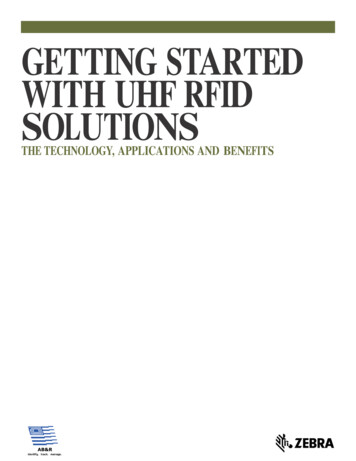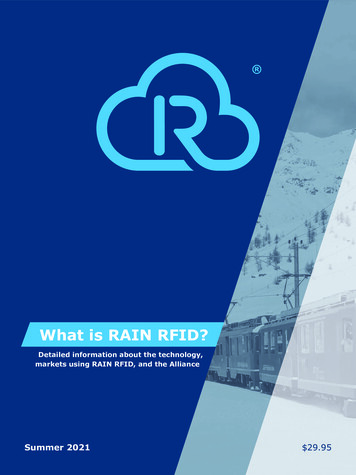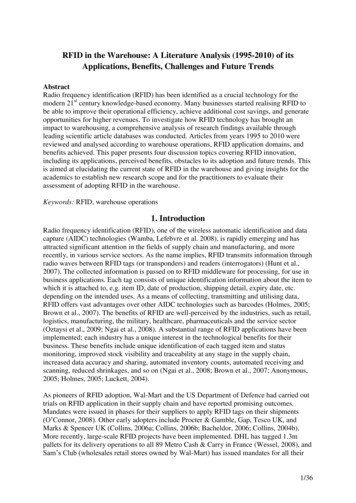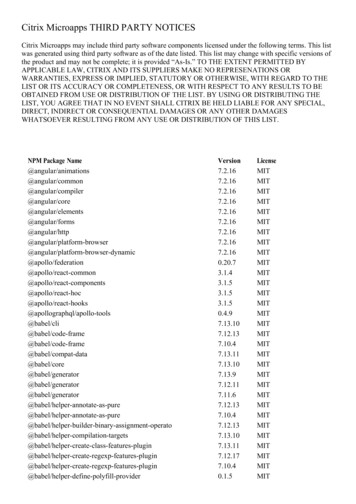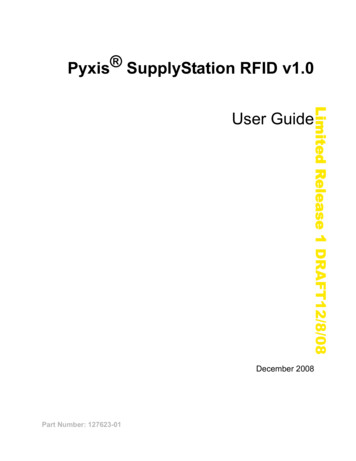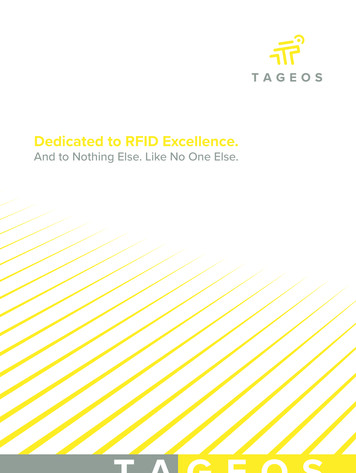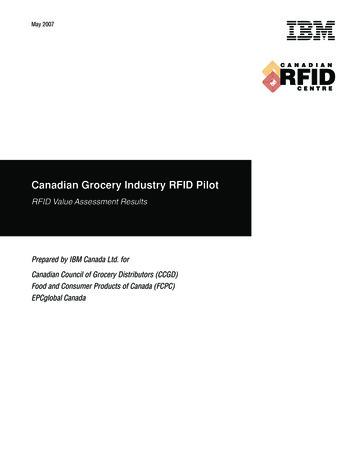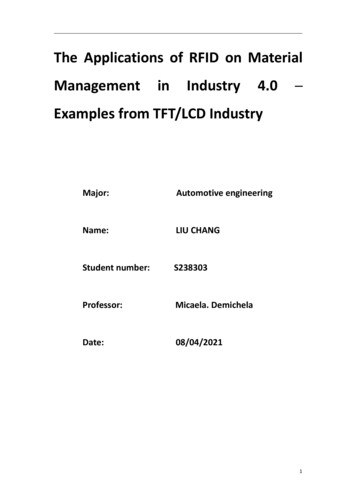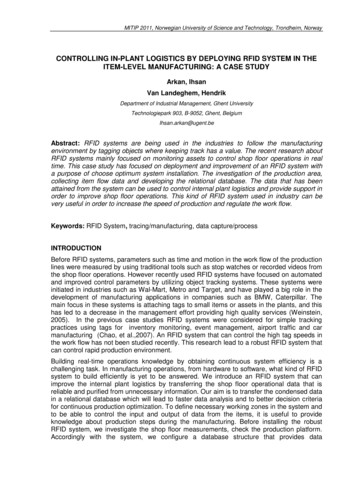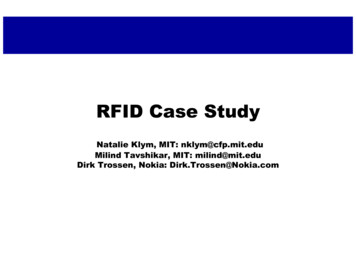
Transcription
RFID Case StudyNatalie Klym, MIT: nklym@cfp.mit.eduMilind Tavshikar, MIT: milind@mit.eduDirk Trossen, Nokia: Dirk.Trossen@Nokia.com
26. Outline Progress of RFID research RFID background and basics Evolving coreness of control points The future of RFID – IP Hourglass analogyRFID Case Study
27. Progress of RFID Research June-September 2004 Pre-methodology overview of RFID Focus on 1st wave applications and ID resolution schemes Introduced 2nd wave applications June-September 2005 Broaden application scope Deeper investigation into individual cases Apply methodology to general findingsRFID Case Study
28. A brief history of RFIDRFID is the “oldest new technology”RFID isinvented inabout 1948Early RFIDexperiments1950Development ofRFID theory &early field trials19601959Aircrafttracking(military)Reductions insize and costof technologyIntense RFIDdevelopmentEarly adopterimplementations1970RFIDapplicationsenter themainstream19801980sLivestocktrackingEmergence ofstandards &wider deploymentAuto ID Centerfounded in 199919901990sToll collectionRailcar trackingMandates announcedRFID marketplace emergesApplication innovation2005: “year of the pilot”RFID integrated into daily life20002000sSupply chainTransportation/logisticsSecurity & access controlPassportsLibrary systemsPet trackingToll road controlHealthcareDigital Card MallToysChild trackingMobile phone apps
29. The evolution of RFID networks Today’s RFID technology has a huge legacy inclosed loop, highly specialized, and costlyapplications RFID has thus evolved into mostly proprietarytechnology characterized by closed standards1 Today’s RFID landscape is dominated by islands ofsingle-purpose, custom RFID networksRFID Case Study
30. RFID key componentsRFconnectionRFID Tag /wirelessnetworksRF transmissionRFID servicesTag/itemRelationshipdatabaseID resolution &/orservice invocationRFID is essentially the transmission of objectrelated data from a tag to a reader via RFtechnology, and onward to a host computer toinvoke an RFID service.RFID Case StudyRFIDapplications
31. RFID key components – control r ityTag distributionTag programmingTag manufacturingWired/wirelessnetworksRFID control pointsRFID Case StudyRFID nsSoftware distributionRFIDtagsRFIDreaderSoftware creationRFconnectionID ResolutionRFID Tag data
32. Evolving coreness of control pointsRFconnectionRFID Tag /wirelessnetworksCustom built networks High scarcity Most of today’s RFIDimplementations are proprietary,closed-loop (internal) systems Hardware & software componentsare application-specific Control points are verticallyintegrated & non-interchangeableRFID Case StudyRFID nsProp.IDCustomapps Low demand Demand is growing, but RFID remainsimmature Supply chain (EPC) apps havegenerated hype, but mostimplementations are slap & ship(minimal compliance) Most other (non-EPC)implementations remainexperimental Consumer apps on the horizon
33. Evolving coreness of control points?ScarcityKey trends movingforward?1995?2000 EPCglobal Network Universal standards enablethe global supply chain Other RFID systems Non-EPC tag data & resolution schemes Non-EPC wireless technologiesRFID Case Study2005FutureDemand
34. EPCglobal NetworkRFID Tag dataRFconnectionRFIDtagsRFIDreaderRFID rksGen I Class 0, Class 1Gen plicationsEPC-IS The vision is to standardize all RFID technology components and centralize IDresolution Tags are encoded with an EPC number Tagged objects pass through standardized networks across the supply chain Current implementations subscribe to EPC numbering and tag/reader networkstandards only The original ONS (Object Naming Service) design is obsoleteRFID Case Study
35. EPCglobal Network (con’t) The EPC platform was intended to drive adoption oflow-cost, passive RFID technology But demand could stagnate― Extra cost (to suppliers & DoD)― Lack of short-term ROI for suppliers― Efficiencies (out of stocks) not compelling― Asset management shows higher short-term gains― Standards are not yet fully defined― Gen II standards not ratified by ISO― Standards for 13.56MHz tags not ratified― Non-retail industry resistance (e.g., healthcare industry)― Cost/performance profile addresses supply chain needs primarilyRFID Case Study
36. Other (non-EPC) RFID systemsRFID Tag dataRF sWired/wirelessnetworksRF transmissionNon-EPC RF technologies Custom RFID networks E.g., 433MHz ISM (industrial, scientific,medical) band Pre-existing short-range wireless networks E.g., Kidspotter child tracking app uses activeWi-Fi tagsMAC address serves as unique identifier NFC (Near Field Communication) Very short range RFID (13.56MHz, 106/202kbps, 0-20 centimeter range)Contactless smartcards & mobile phones (50%of phones NFC-enabled by 2009)RFID Case StudyRFID nsID resolution &/orservice invocationNon-EPC tag data &ID resolution schemes Competing supply chain ID e.g., Japan’s UCode vs EPC EPC Alternatives URL DNS IP address DNS XPath expression DNS/local query Proprietary codes e.g., DoD’s UID internal registry Any internal system
37. The future of RFID networks? The RFID landscape will remain heterogeneous Multiple ID schemes Multiple wireless networks Multiple application platforms How can multiple RFID systems be managed? The IP Hourglass analogyRFID Case Study
38. The future of RFID – IP Hourglass analogyThe 1980sThe (Telcos) Visionin the 90s . .Different NetsATMDifferent NetsDifferent MACsTodayThe IP HourglassServicesIPAALxATM over 802.11802.16802.11gSONET, FDDIW-CDMADifferent radiosRFID Case StudyDifferent radioswith the ATMForum asthe controlling bodyCDMAOFDM
39. The future of RFID – IP Hourglass nshipdatabaseRFIDreadersRFIDreaderFuture: The RFID Hourglass?Manage divergence at middleware layer, similar to IPRFIDtagsRFconnectionRFIDTag dataEPCglobal’sVision:Universal standardsRFID MiddlewareConnectivityRFID servicesToday: Heterogeneous RFIDnetworks
40. The future of RFID – IP Hourglass analogyHow does the hourglass model apply to RFID? Who is the next IP-like player, i.e., who will be the Ciscoof RFID? Who will be the IETF of the RFID world? Are certain constructs in EPCglobal accelerating thistrend? E.g., licensing/registration scheme (imagine similarscheme had been in place for IP) Will this trend accelerate through increased usage ofother radios and tagging techniques (even re-used onessuch as IMEIs)?RFID Case Study
RFID applications Tag manufacturing Tag programming Tag distribution Tag/reader connectivity Reader manufacturing Reader distribution Reader connection ID Resolution Software creation Software distribution . ―Non-retail industry resistance (e.g., healthcare industry) ―Cost/performance profile addresses supply chain needs primarily RFID .


